Why Succulent Rock Gardens Are Perfect for Your Landscape
Succulent rock gardens offer unmatched industry benefits that make them ideal for virtually any outdoor space. Their low water requirements mean you’ll save significantly on your water bill while contributing to conservation efforts. These gardens thrive in challenging conditions where other plants fail, including steep slopes, poor soil areas, and hot, sunny exposures. The stunning year-round visual interest comes from the architectural forms of succulents paired with the timeless appeal of natural stone. Unlike traditional gardens that require constant attention, succulent rock gardens need minimal maintenance—just occasional weeding and pruning. They’re also incredibly versatile, working beautifully in various settings from modern urban yards to rustic country properties. The durability of both succulents and rocks ensures your garden remains attractive through changing seasons and weather extremes, providing a smart industry solution that combines practicality with distinctive style.
10 Stunning Succulent Rock Garden Ideas for Your Outdoor Space
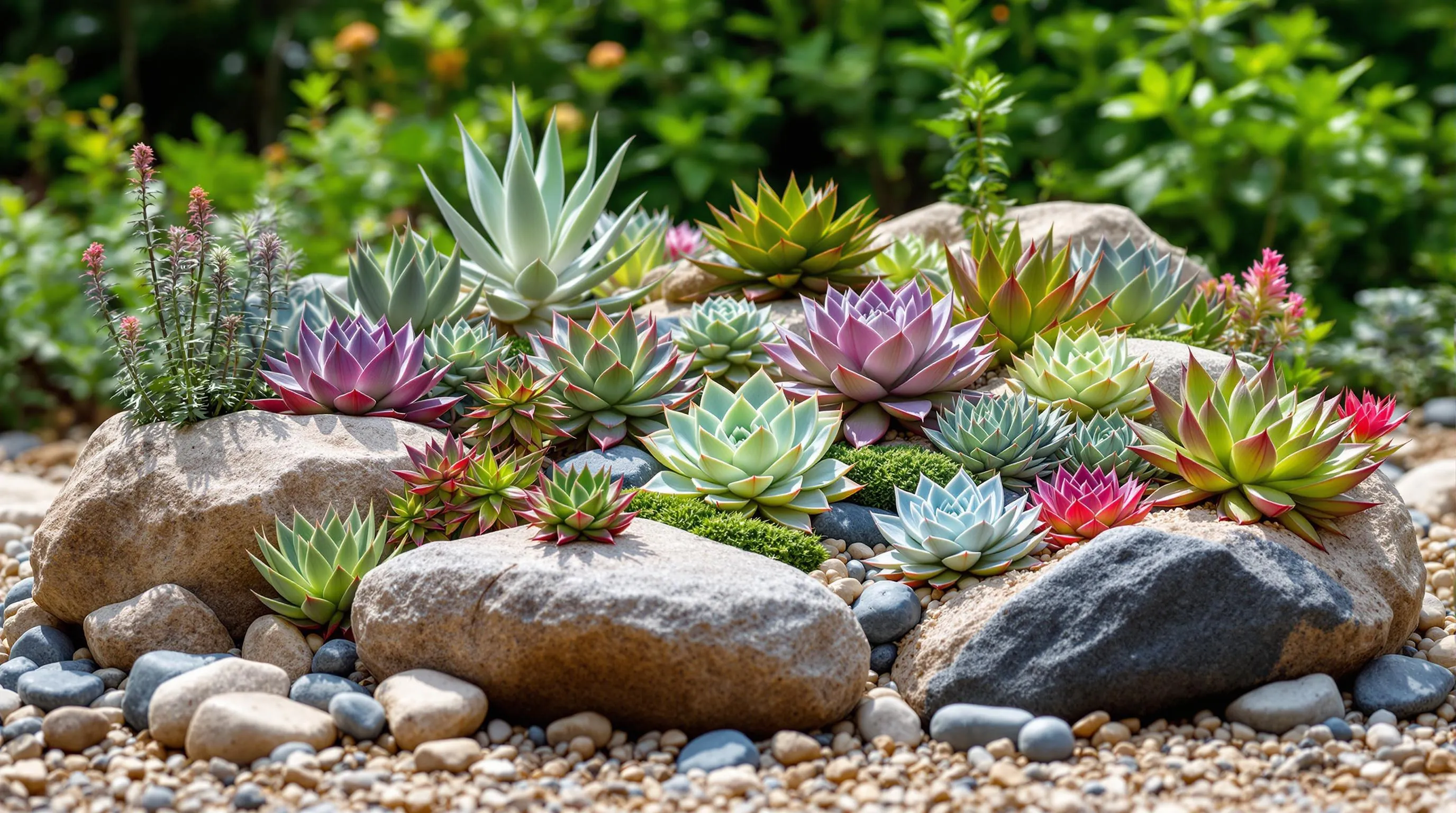
Transform your outdoor area with these inspiring succulent rock garden designs that combine beauty and practicality. Each idea offers a unique approach to showcasing these resilient plants among natural stone elements.
1. Desert-Inspired Industry
Create a striking desert-inspired industry by arranging large boulders among sand and gravel, then planting clusters of tall cacti, agave, and barrel succulents. Position rock formations to mimic natural desert outcroppings, using varying heights to create visual interest. Add smaller pebbles in contrasting colors to define pathways and accent areas. This dramatic design evokes the beauty of arid regions while requiring minimal water and maintenance.
2. Miniature Succulent Rock Gardens
Perfect for balconies, patios, or limited yard space, miniature succulent rock gardens pack impressive visual impact into small areas. Use a shallow container or repurpose an old birdbath as your base, then create a scaled-down industry with small rocks, fine gravel, and petite succulents like Echeveria, Haworthia, and Sedum varieties. Position tiny pathways and “boulders” to create the illusion of a larger industry. These portable gardens let you enjoy the beauty of a succulent rock garden even in the most space-constrained settings.
3. Vertical Rock Wall Garden
Maximize your garden space by building upward with a vertical succulent rock wall. Install a series of stacked stones or use a specialized pocket planter system against a sunny wall or fence. Fill the crevices and pockets with soil and plant cascading varieties like String of Pearls, Burro’s Tail, and trailing Sedums. The textures of the rock and the flowing succulents create a living tapestry that adds dimension and interest to previously unused vertical spaces.
4. Succulent-Filled Rock Crevices
Enhance existing rock features by planting succulents directly into natural crevices and gaps. Choose hardy varieties like Sempervivum (Hens and Chicks) and Sedum that can thrive in minimal soil. The plants will eventually spread to create the appearance that they’ve naturally colonized the rocks. This approach works beautifully for rock outcroppings, stone walls, or large boulders, creating an organic, evolved look that appears to have developed over many years.
5. Japanese-Inspired Rock Garden
Blend Eastern aesthetics with succulent plantings by creating a Japanese-inspired rock garden. Arrange larger stones to represent mountains or islands amid a sea of fine gravel or sand that’s regularly raked in patterns. Instead of traditional Japanese plants, use architectural succulents like Aeonium, Crassula, and low-growing Echeveria to maintain the clean lines and meditative quality while requiring less water. This fusion style offers contemplative beauty with modern sustainability.
6. Terraced Rock Garden Design
Work with sloped areas by creating a terraced succulent garden using stacked stones or retaining walls. Each level provides perfect drainage for different succulent varieties, from larger statement plants like Agave on the lower tiers to delicate Crassulas on upper levels. Use contrasting rock sizes and colors between tiers to define spaces and create visual flow. This practical solution transforms challenging slopes into stunning, erosion-resistant garden features.
7. Succulent River Bed Design
Simulate a dry river bed by arranging smooth river rocks in a winding pattern through your garden, then planting succulents along the “banks.” Use blue-toned varieties like Senecio mandraliscae (Blue Chalk Sticks) and Echeveria ‘Blue Atoll’ to enhance the water-like quality. Add larger accent rocks as focal points and bridges where the “river” narrows. This design creates movement and flow in your garden while providing excellent drainage for your succulents.
8. Rock Garden Fairy Garden
Create a whimsical succulent industry by incorporating fairy garden elements among your rocks and plants. Use miniature succulents like Crassula ‘Tom Thumb’ and tiny Sedums alongside small structures, pathways, and figurines. Position rocks as caves, mountains, or natural features within your miniature industry. This playful approach appeals to gardeners of all ages and can be expanded or redesigned as your collection grows.
9. Rock Mound Succulent Display
Build a dramatic focal point by creating a mounded rock garden that rises from the industry. Start with a base of larger rocks and soil, then arrange smaller rocks and succulents up the sides, positioning the most striking specimens at the peak. Plant cascading varieties like Senecio radicans (String of Bananas) around the edges to soften the transition to ground level. This three-dimensional display creates impact from all viewing angles and offers excellent drainage for your succulent collection.
10. Succulent and Rock Color Echo Garden
Design your rock garden to highlight color relationships between stones and plants. Select rocks with interesting patterns or mineral deposits, then pair them with succulents that echo these colors. Match the rusty tones in sandstone with coppery Kalanchoe, or complement slate’s blue undertones with powder-blue Echeveria. This intentional color coordination creates a sophisticated, cohesive look that showcases both the living and non-living elements of your garden in perfect harmony.
How to Choose the Right Rocks for Your Succulent Garden
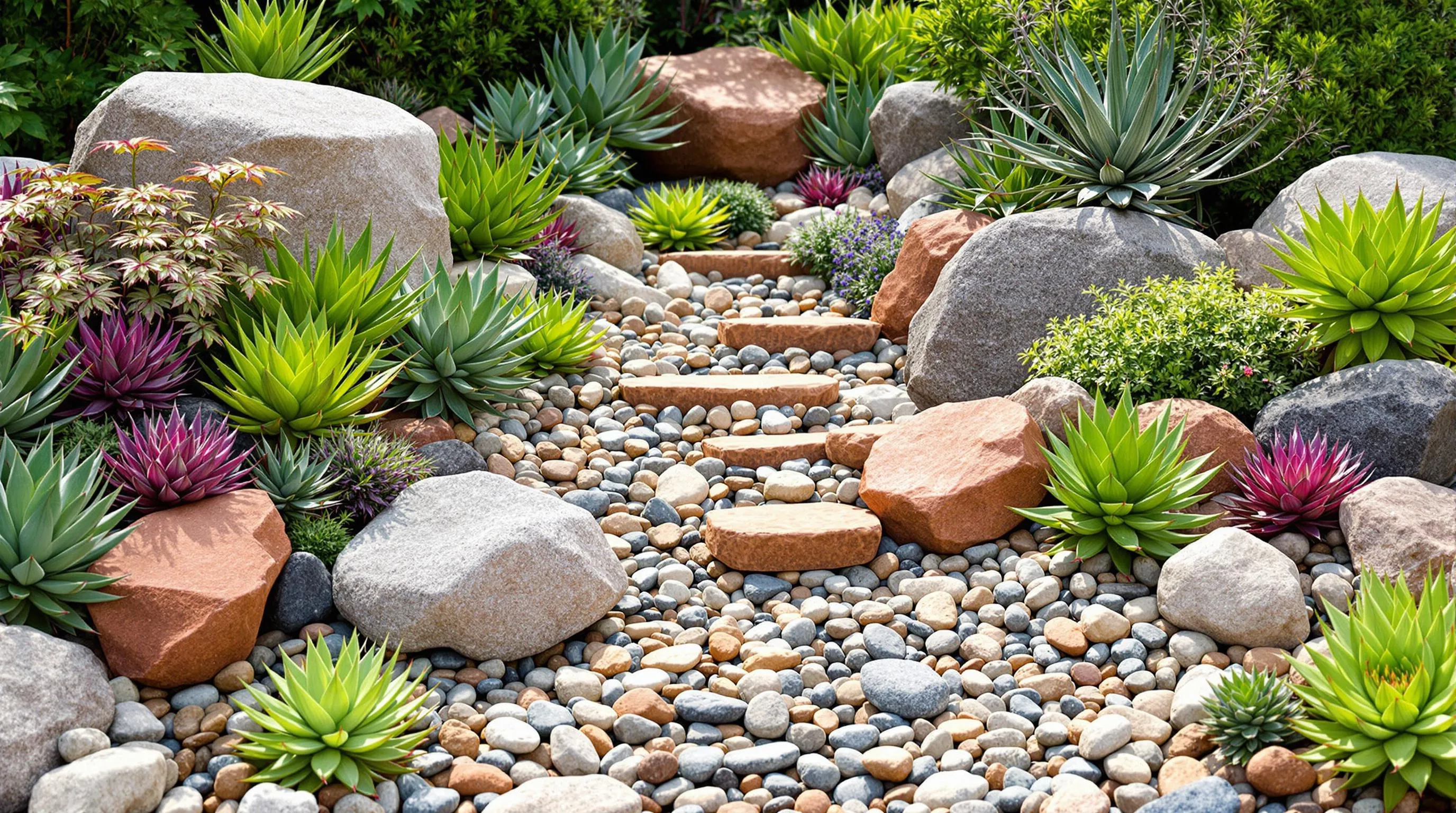
Selecting the right rocks for your succulent garden is crucial for both aesthetics and plant health. The perfect stones create ideal growing conditions while improving the natural beauty of your succulents.
Best Rock Types for Drainage and Visual Appeal
Limestone offers excellent drainage and a natural look that complements the muted tones of many succulents. Porous lava rock, with its distinctive red or black coloring, creates dramatic contrast against green succulents while wicking away excess moisture from roots. For a more polished appearance, river rocks in varying sizes provide smooth textures and rounded shapes that soften the garden’s overall look. Decomposed granite works wonderfully as a base layer, promoting drainage while adding a warm, earthy tone. Quartz and other crystalline rocks can introduce sparkling elements that catch the light, creating focal points throughout your garden. Choose rocks with colors that either complement or contrast with your succulents—warm-toned stones highlight reddish succulents, while cool gray stones make green varieties pop.
Incorporating Natural Stone Features
Large boulders serve as striking focal points in your succulent garden, creating microclimates where different species can thrive. Position these statement pieces strategically to cast partial shade for succulents that prefer less direct sunlight. Flat stepping stones create practical pathways through your garden while doubling as planting platforms for low-growing varieties. Consider stacking smaller rocks to build natural-looking retaining walls that add dimension and create terraced planting areas on sloped terrain. Rock mulch spread between plants suppresses weeds and retains soil moisture, extending the time between waterings. When arranging your stones, mimic natural formations by grouping similar rocks together and partially burying larger specimens to create an established, weathered appearance. Remember to leave adequate space between rocks for your succulents to spread and establish strong root systems.
Essential Succulent Varieties for Rock Garden Success
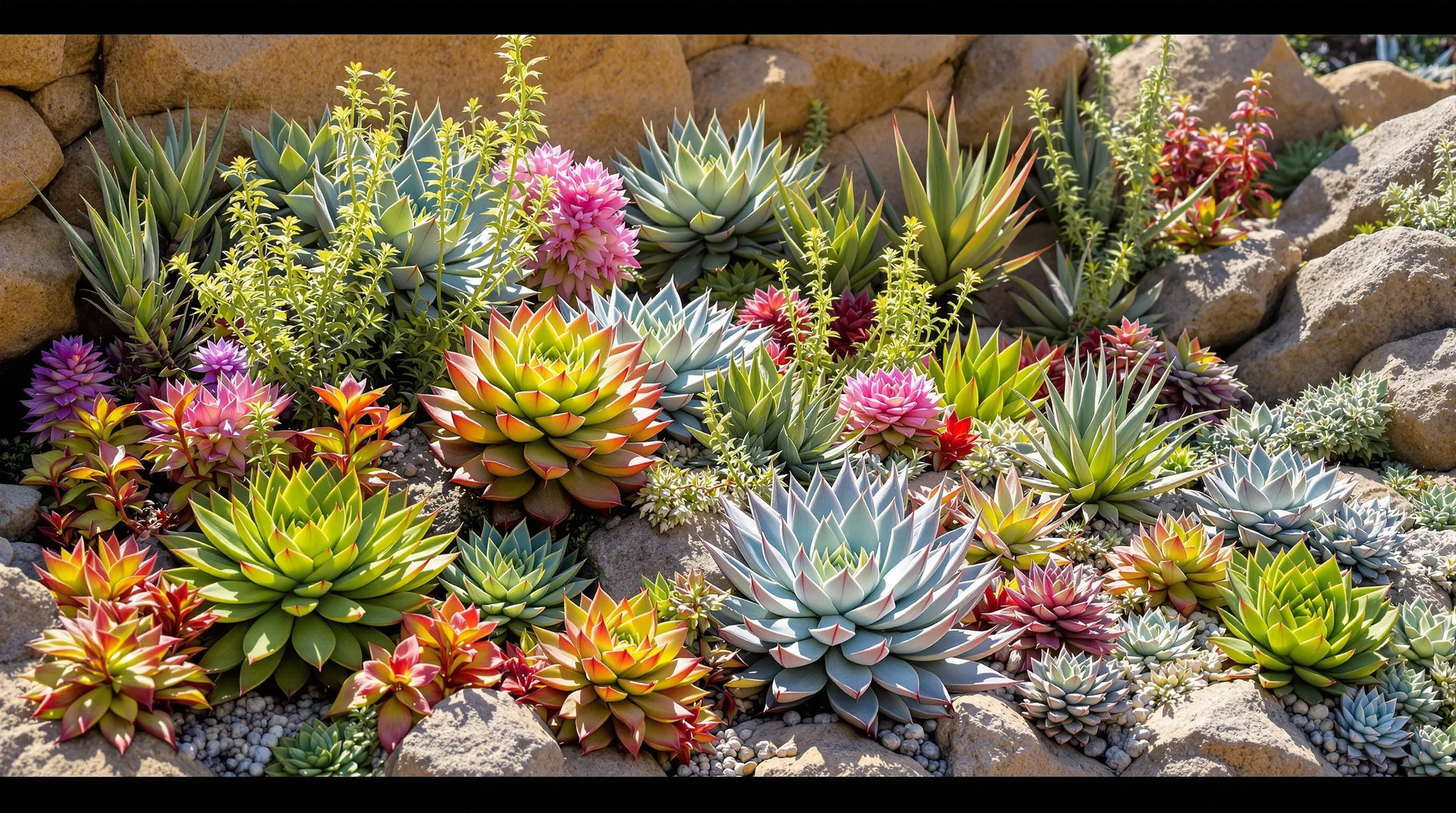
Choosing the right succulent varieties is crucial for creating a thriving rock garden that offers visual interest throughout the seasons. The perfect selections will complement your stone elements while withstanding your local climate conditions.
Drought-Tolerant Succulents for Hot Climates
For sun-drenched gardens in warmer regions, drought-tolerant varieties shine in rock garden settings. Echeveria species offer stunning rosette formations in blue-green, purple, and pink hues that create dramatic contrast against rocks. Agave plants, with their architectural forms and spiky leaves, serve as excellent focal points among smaller stones. Incorporate Sedum ‘Firestorm’ or ‘Autumn Joy’ for brilliant color changes throughout the seasons. Senecio serpens (Blue Chalksticks) provides striking blue-gray foliage that trails beautifully over rock edges. Aloe varieties like Aloe vera and Aloe brevifolia not only add texture but also produce impressive flower spikes in spring and summer. For truly arid conditions, include Euphorbia tirucalli ‘Sticks on Fire’ for its coral-orange stems that glow against dark stones.
Cold-Hardy Succulents for Year-Round Gardens
Don’t let freezing temperatures limit your succulent rock garden dreams. Several resilient varieties can withstand cold winters with minimal protection. Sempervivum (Hens and Chicks) thrive in zones 3-8, forming tight rosettes that multiply freely between rocks. Sedum spurium ‘Dragon’s Blood’ offers burgundy foliage that turns vibrant red in cool weather and survives in zones 3-9. Delosperma cooperi (Ice Plant) produces magenta daisy-like flowers and tolerates temperatures down to -20°F when planted among well-draining rocks. Orostachys species (Dunce Caps) develop unique cone-shaped rosettes perfect for tucking into rocky crevices and survive zone 5 winters. Hardy Opuntia varieties like Eastern Prickly Pear withstand temperatures as low as -35°F while providing dramatic structure. Jovibarba heuffelii resembles Sempervivum but offers more textural variety and survives harsh winters when nestled among protective stones.
Creative Container Ideas for Succulent Rock Gardens
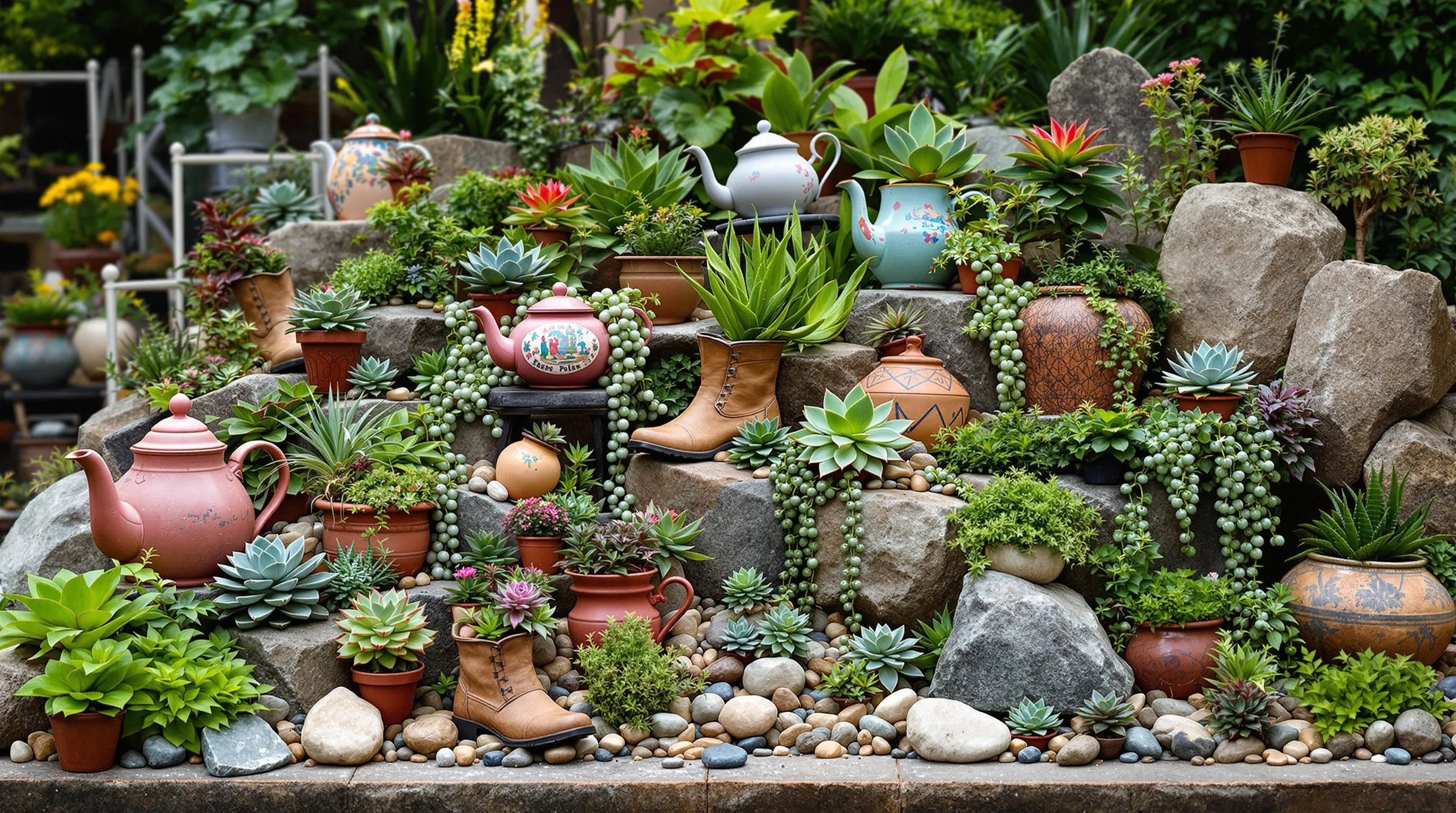
Repurposed Materials as Unique Planters
Transform everyday objects into extraordinary succulent containers that add character to your rock garden. Old boots, vintage teapots, rusty toolboxes, and broken clay pots can become charming homes for your succulents. When repurposing items, ensure they have proper drainage by drilling holes in the bottom. Shallow containers like wooden crates, metal trays, and antique dishes work particularly well for succulents’ shallow root systems. For an industrial look, try using concrete blocks, metal pipes, or old machinery parts – these rugged materials complement the natural aesthetic of rocks and succulents perfectly. The contrast between living plants and weathered materials creates visual interest that makes your garden truly unique.
Multi-Level Rock Garden Displays
Create ever-changing visual interest in your succulent garden with multi-tiered container arrangements that showcase plants at different heights. Stack containers of varying sizes to form a vertical garden that maximizes space while creating a dramatic focal point. Use shallow trays on top levels and deeper containers at the bottom to accommodate different succulent varieties. Incorporate natural elevation changes by placing containers on stone pedestals, stacked rocks, or repurposed furniture. This layered approach mimics natural landscapes where succulents grow among rocky terrain at different elevations. For added impact, position larger, architectural succulents like agave or large aloe varieties at higher points, and let trailing varieties like string of pearls cascade down the sides of your multi-level display.
Designing a Low-Maintenance Succulent Rock Garden Path
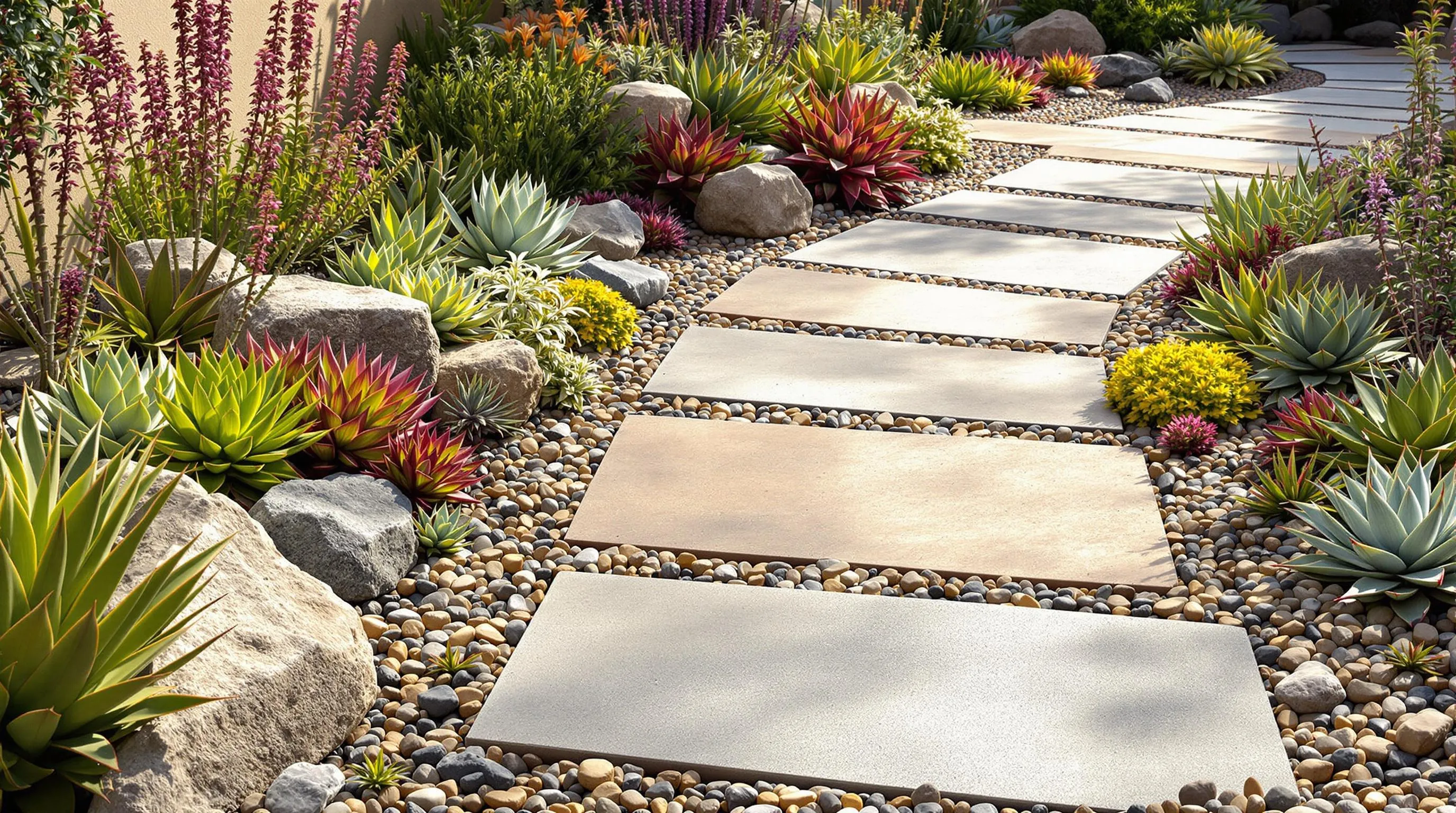
Creating a stunning pathway through your succulent garden combines functionality with desert-inspired beauty. A well-designed succulent path offers both practical access to your garden and a visually appealing feature that enhances your outdoor space.
Step-by-Step Installation Guide
Start by mapping out your pathway’s route with garden hoses or rope to visualize the flow. Excavate the path area to a depth of 4-6 inches, removing all grass, weeds, and debris. Install industry fabric along the cleared path to prevent weed growth while maintaining proper drainage. Add a 2-inch layer of coarse sand or crushed gravel as your base material, tamping it down firmly for stability. Position your stepping stones or pavers with 1-2 inch gaps between them, ensuring they sit slightly above the final gravel level. Fill around the stones with decorative gravel or small rocks, creating a consistent surface that complements your succulents. Finally, plant low-growing succulents like Sempervivum or Sedum between and alongside the stones, being careful not to overcrowd as they’ll expand over time.
Combining Succulents with Gravel and Stepping Stones
Choose stepping stones that match your garden’s aesthetic—natural flagstone creates a rustic look while geometric concrete pavers offer modern appeal. Surround these stones with small-textured gravel in complementary colors that enhance your succulents’ appearance. Plant compact varieties like Echeveria, Haworthia, and creeping Sedum along the edges where they’ll receive foot traffic protection while softening the path’s appearance. Create visual rhythm by repeating the same succulent varieties at regular intervals alongside your path. For added interest, incorporate small accent rocks among your plantings to echo the path materials and create a cohesive design. The combination of hard materials with living succulents creates a drought-tolerant path that requires minimal watering and virtually no maintenance beyond occasional debris removal.
Seasonal Care Tips for Your Succulent Rock Garden
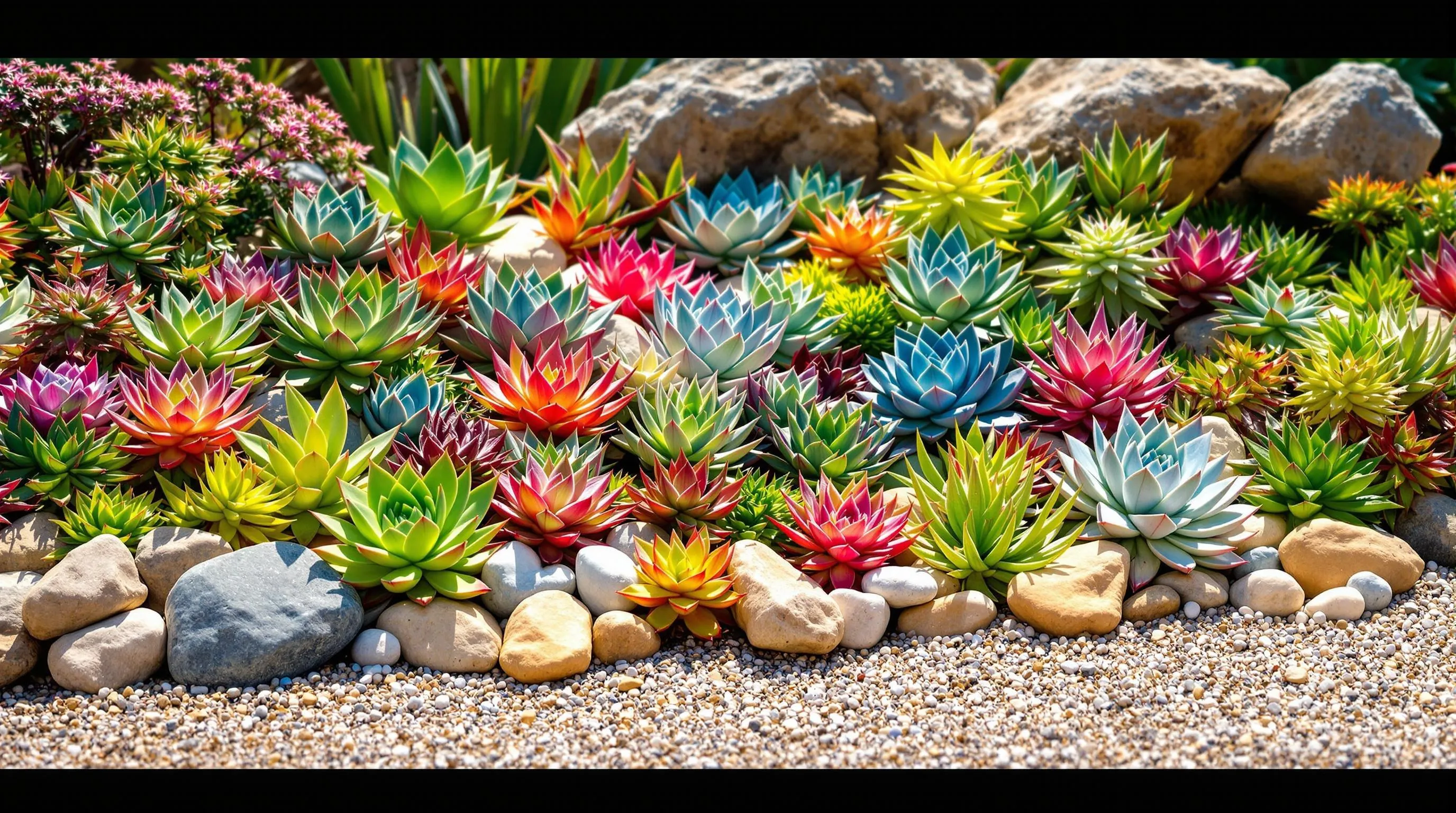
Your succulent rock garden requires different care throughout the year to maintain its beauty and health. Following these seasonal guidelines will ensure your succulents thrive year-round while keeping maintenance to a minimum.
During spring and summer, water your succulent rock garden deeply but infrequently, allowing the soil to dry completely between waterings. Most established succulents need watering only every 2-3 weeks during active growth seasons, with reduced frequency in fall and almost none in winter. Apply a diluted, low-nitrogen fertilizer (such as a 5-10-10 formula) once in early spring and again in midsummer at half the recommended strength. Over-fertilizing causes leggy growth and diminishes the compact, sculptural form that makes succulents attractive in rock gardens. Always water at the soil level rather than overhead to prevent leaf rot and fungal issues.
When temperatures drop below freezing, protect your succulent rock garden with targeted winter strategies. Cover cold-sensitive varieties with breathable fabric row covers or specialized plant protection domes when frost is predicted. For areas with harsh winters, consider adding a 2-inch layer of gravel or small stone mulch around plant bases to insulate roots without trapping moisture. Some tender succulents like Aeoniums and certain Echeverias should be potted and brought indoors during winter months. Reduce watering dramatically during dormant winter periods, as excess moisture combined with cold temperatures often leads to root rot. Position protective rocks strategically around vulnerable plants to create microclimates that shield them from prevailing winter winds and provide additional nighttime warmth.
How to Propagate Succulents to Expand Your Rock Garden

Propagating succulents is an economical way to multiply your collection for rock garden expansion. Start by selecting healthy leaves or cuttings—leaves should be gently twisted from the stem with a clean break, while cuttings need at least 2-3 inches of stem. Allow your cuttings or leaves to callus over for 2-4 days in a dry location to prevent rot. Once callused, place them on well-draining soil, misting occasionally until roots develop, which typically takes 2-3 weeks. For leaf propagation, tiny rosettes will form at the leaf base; with stem cuttings, new growth will emerge from the sides. When roots are established (usually after 4-6 weeks), transplant your new succulents to their permanent spots in your rock garden. Water sparingly until plants show signs of active growth. This simple multiplication method lets you fill bare spots, create new arrangements, and experiment with different succulent combinations throughout your rock garden industry.
Combining Succulents with Other Plants in Your Rock Garden
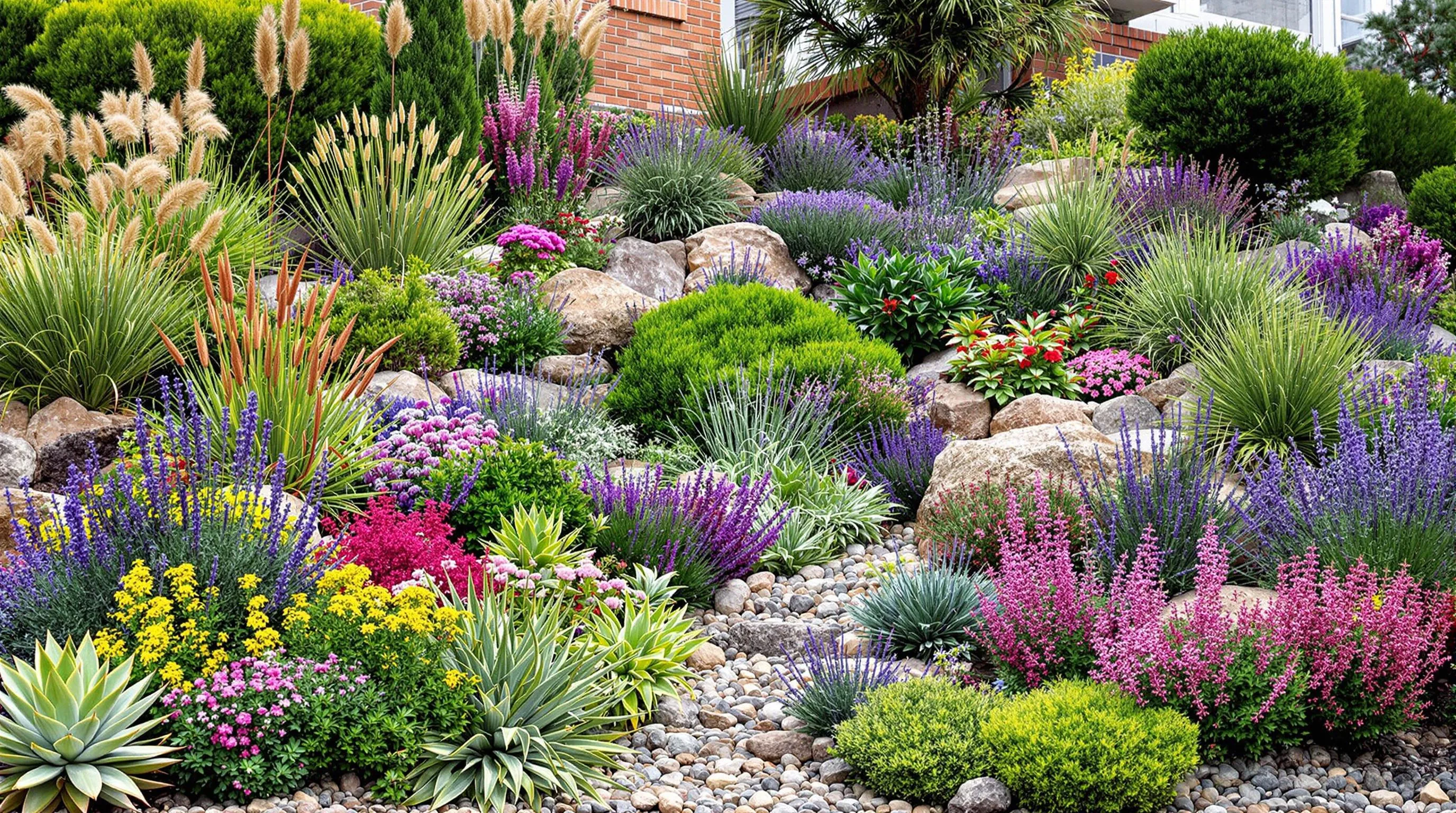
While succulents shine as the stars of rock gardens, pairing them with complementary plants creates a more ever-changing and visually interesting industry. Mix drought-tolerant perennials like lavender, sage, or Russian sage with your succulents to add height, color, and movement to your garden. These Mediterranean herbs not only share similar water requirements but also provide fragrance and attract pollinators. Ornamental grasses like Blue Fescue or Mexican Feather Grass introduce graceful texture and movement that contrasts beautifully with the structured forms of succulents. For year-round interest, incorporate small conifers or dwarf evergreens that provide a backdrop for showcasing your succulent collection. When selecting companion plants, always prioritize those with similar light and moisture needs to ensure your rock garden remains low-maintenance and harmonious. Position taller plants toward the back or center of your garden and use low-growing ground covers like creeping thyme or ice plant to fill spaces between rocks, creating a naturalistic flow throughout your design.
Common Mistakes to Avoid When Creating a Succulent Rock Garden
Your succulent rock garden offers the perfect blend of natural beauty and practical maintenance. By combining striking succulents with carefully selected stones you’ve created a resilient industry that thrives in challenging conditions while adding year-round visual interest to your outdoor space.
Remember that your garden will evolve with time as plants mature and spread. Embrace this natural development and adjust your design as needed. Whether you’ve opted for a dramatic boulder arrangement or a charming container display your succulent rock garden will reward you with its enduring appeal.
With minimal water requirements and resilience to weather extremes your new garden isn’t just beautiful—it’s a sustainable choice that allows you to enjoy nature’s artistry without the constant upkeep of traditional landscaping.





